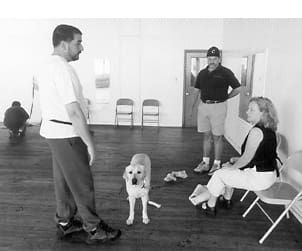My three-year-old Jack Russell Terrier has begun displaying aggression (to people and other dogs) and Ive been told that a regular trainer just wont fix his problems. Various friends (including my veterinarian) have told me to consult a trainer, a positive trainer, a behaviorist, a behavior counselor…Excuse me, but is there any real difference between these people other than the titles?
-Name withheld by request
We put this question to Pat Miller, WDJ’s Training Editor. Miller is a professional dog trainer residing in Fairplay, Maryland, a freelance writer, and author of The Power of Positive Dog Training (2001, Howell Book House). She is also a member of the Board of Directors of the Association of Pet Dog Trainers. Miller responds:
I’m not surprised that you are mired down in terminology; it is confusing, even for those of us who work in the training profession. This is in large part due to the fact that unlike the medical profession (and many others), most of the positions in our field presently require no formal education, certification, or licensing other than a standard business license.
The only exception to this is the title of Certified Behaviorist, which denotes that the titleholder has been certified by the Animal Behavior Society (ABS) as an Applied or Associate Applied Animal Behaviorist. These folks all have letters after their names they hold either DVM (or VMD), PhD, ScD or MS degrees, or a combination thereof. There are currently about 30 of these worldwide on the ABS list.
Although not mandated by law, it is also generally accepted in the training profession that the title of behaviorist denotes someone with a graduate degree in animal behavior, though they are not necessarily certified. Trainers who do not have graduate degrees in behavior but who consider themselves experienced in and capable of dealing with behavior modification challenges and who offer such services, generally use the titles of behavior consultant or behavior counselor.
Those who call themselves trainer usually narrow their focus to the teaching of specified behaviors, such as basic and advanced levels of good manners training, and more specialized training for the many and various canine sports. They may do some behavior problem-solving as well, but tend to leave the serious stuff, like aggression, for those who present themselves as behaviorists or behavior counselors.
My definition of positive trainer may and probably does vary greatly from that of many others who promote themselves as positive trainers. It may also differ from yours. Training methods and philosophies range on a continuum from very compulsive to very positive. I am aware of trainers who have moved toward the gentler end of the scale and as a result now describe themselves as positive, but who still routinely use choke chains, collar corrections, and even shock collars. I do not.
At least one organization has wrestled with the idea of certifying trainers so as to establish and ensure professionalism in the industry; the Association of Pet Dog Trainers recently developed a Level 1 trainer certification program, implemented under an independent affiliate of APDT. The Certification Council of Pet Dog Trainers administered its first test at the APDTs annual training conference in late September 2001. APDT also has visions for the future of offering more advanced levels of certification.
Titles don’t make the trainer
So, that explains the titles but it doesn’t tell you which type of expert is best qualified to handle your dog’s issues.
In my experience, you can’t assume that the person with the most letters after his or her name will be the best person to solve any particular dogs problems. Titles and formal education or a lack thereof do not determine whether or not someone is a good trainer or behaviorist. While Certified Behaviorists and behavior counselors may possess a greater body of knowledge about the science of behavior and learning, this doesn’t guarantee that they are good trainers or teachers!
Experience, teaching skills, openness to new methods and ideas, and a natural affinity with dogs, and an understanding of canine behavior all play important roles. This is why I recommend that you observe any prospective trainer in action before agreeing to work with him or her.
You are your dog’s advocate and guardian. He trusts and depends on you. Whether you utilize the services of a trainer, a behavior counselor, a behaviorist, or a Certified Behaviorist, it is your obligation to protect him from harm. Have faith in your own instincts.
Finally, if your animal care or training professional ever does or asks you to do anything that you don’t want done to your dog, you have the absolute right as well as the obligation to intervene and stop the procedure. Dont ever let anyone talk you into doing something to your dog that you know in your heart is wrong. Your dog’s trust is a priceless gift. Be worthy of it.






